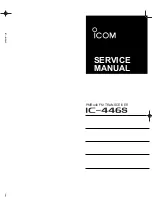
— 13 —
You may turn the knob completely counterclockwise to
OFF
to deactivate the alarm altogether.
The trip point of the audio loss alarm is fixed at a program
peak level about 15dB below 100% modulation. Even classi-
cal music will have peaks that exceed this level regularly.
Do consider the dynamics of the broadcast format when
setting this delay. For classical music a setting of 60 se-
conds would probably still exceed most legitimate
pianissi-
mo
passage; Ravel’s
Bolero
, unprocessed, a possible excep-
tion.
The rear-panel
A
terminal is an NPN transistor saturation to
ground for an audio-loss alarm. This ground may be used
to actuate a relay, light an LED at a remote location or tie-in
to a remote control system.
FM Reception Modes
(Menu Screen 4B)
Once
A-LOSS:
has been set, push the knob again.
StMODE
will begin to blink on the lower line of Menu Screen 4. To
set the FM mode, turn the knob to select
Stereo
, generally
the normal receiver operating mode, or to select
Blend-St
(blended stereo) or
F-Mono
to force monaural FM reception.
With
Stereo
selected, the receiver will attempt to decode
any FM stereo transmission regardless of signal quality. In
the
Stereo
mode, the noise-reducing stereo-to-mono ‘blend’
feature, common to most modern FM receivers, is
not
en-
gaged. The mode display in Menu 1 will show
FM:S
for ste-
reo broadcasts and
FM:M
if the station is transmitting a
monaural signal.
Stereo-FM suffers a theoretical noise disadvantage of about
20dB when compared with monaural transmission. Select-
ing the
Blend-St
reception mode will mitigate this condi-
tion substantially by progressively ‘blending’ the stereo im-
age to mono as the FM signal deteriorates under a low-
signal, multipath or other poor reception condition. This
mode is identified with
FM:B
in Menu Screen 1.
The degree of blending is not indicated, nor will the screen
indicate
FM:M
if the station reverts to a monaural transmis-
sion. In the
FM:B
(blended) mode, you may switch among
the three options to evaluate the audible differences: either
a noise tradeoff between
Blend-St
and
Stereo
, or the sep-
aration tradeoff between
Blend-St
and
F-Mono
. The blend-
ing option is included in the 633 to at least offer a feature
— 14 —
common to consumer radios, but it well may be considered
“cheating” in a professional environment.
F-Mono
, or Forced-Mono, will place the 633 receiver in a
monaural-only reception mode. This might be a valid
choice when monitoring or relaying a station that never
broadcasts in stereo.
Program Audio Levels
(Menu Screen 5)
Menu Screen 5 gives a
bargraph presentation of
program audio levels.
This is a peak-respond-
ing meter with a floating
peak-hold function.
100% modulation is denoted by the large block opposite the
0dB marking on the panel. The meter re1, +2 and
+3dB above 0dB. Below 0dB the scale is linear in 0.5dB
steps down to –15dB, and then in 1dB steps to –21dB.
0dB represents ±75kHz carrier deviation. A 400Hz monau-
ral test tone would take the meter to the 0dB point. At
higher frequencies receiver de-emphasis must necessarily
be factored into the reading, and of course with stereo
broadcasting the 19kHz pilot consumes the top 1dB of
modulation. Aggressively-processed program audio should
peak the bargraphs consistently at about –1.5dB.
Headphone Monitoring
(Menu Screen 6)
A front-panel
PHONES
jack offers a convenient monitoring
point for 633 setup and casual listening. Whenever a pair of
headphones is plugged into the front-panel jack, the LCD
screen automatically goes to Menu Screen 6.
HEADPHONE
VOL
will begin blinking and the panel knob may be adjusted
for a comfortable listening level.
The LCD shows an arbitrary numerical value and a bargraph
representation of the headphone volume. Once volume is
set, push the knob to save the setting to memory and to re-
turn the screen to the last menu on display.
PS and PTY
(Menu Screen 7)
The upper line of Menu Screen 7 shows the station’s 8-
character
PS:
, or Program Service Name message. This can
































